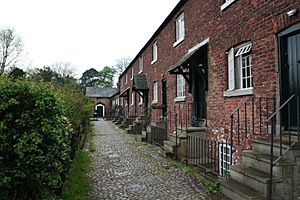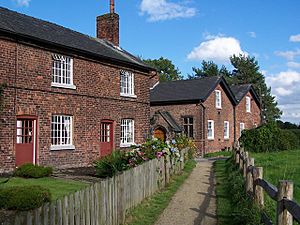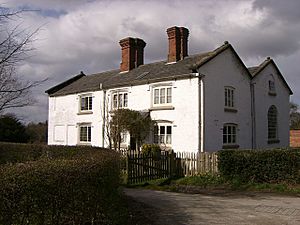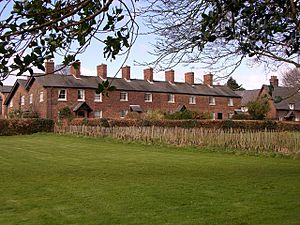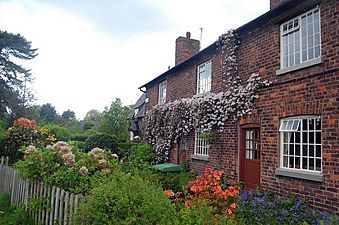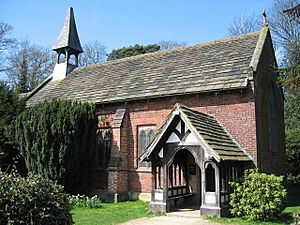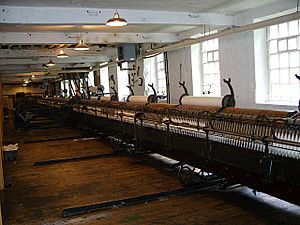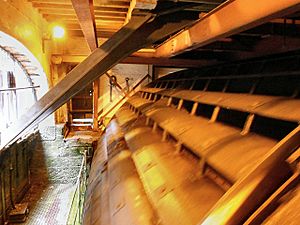Quarry Bank Mill facts for kids
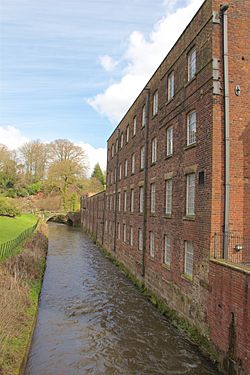 |
|
| Owner | Samuel Greg |
|---|---|
| Further ownership |
|
| Coordinates | 53°20′38″N 2°14′58″W / 53.34390°N 2.24950°W |
| Construction | |
| Built | 1784 |
| Renovated |
|
| Floor count | 5 |
| Power | |
| Date | 1796, 1810 |
| Engine maker | Boulton & Watt |
| Water Power | |
| Diameter / width of water wheel | 32 feet (9.8 m) / 21 feet (6.4 m) |
| Equipment | |
| Mule Frames | |
|
Listed Building – Grade II*
|
|
| Official name | Quarry Bank Mill |
| Designated | 30 March 1951 |
| Reference no. | 1237687 |
Quarry Bank Mill (also known as Styal Mill) is a famous old cotton factory in Styal, Cheshire, England. It's one of the best-preserved textile factories from the Industrial Revolution. This important building was built in 1784 and is now a Grade II* listed building.
Samuel Greg started Quarry Bank Mill. He and his wife, Hannah Lightbody, made many new changes. They improved both the machines and how workers were treated. The Greg family cared for their workers, offering medical help and some education for children. However, everyone worked about 72 hours a week until a new law in 1847 shortened the hours.
Samuel Greg also built homes for his workers. This area is now called Styal Estate. Today, the National Trust runs the mill and Styal Estate as a museum. It's open to everyone and shows what a complete industrial community looked like.
Contents
Exploring Quarry Bank Mill's Location
Quarry Bank Mill is located near Styal in Cheshire, just south of Manchester Airport. The mill sits right on the River Bollin. This river was very important because its water powered the mill's large waterwheels. Roads connected the mill to the Bridgewater Canal. This canal helped transport raw cotton from the port of Liverpool to the factory. In 1909, Styal railway station opened about a kilometer away, making travel easier.
The Mill's Fascinating History
How Quarry Bank Mill Began
Samuel Greg rented land at Quarrell Hole in 1784. He chose this spot because the River Bollin offered a good water supply. It was also close to the Bridgewater Canal, which linked to Liverpool. Greg built the factory to spin cotton. By 1832, when he retired, it was the biggest cotton business in the United Kingdom. The mill still makes cotton calico fabric today.
The Greg family were careful and fair mill owners. They kept expanding and changing the mill over the years. When Samuel's son, Robert Hyde Greg, took over, he added weaving to the mill's work. Samuel Greg passed away in 1834.
Powering the Mill: Water and Steam
The mill used a huge iron water wheel to power its machines. This wheel was designed by Thomas Hewes and built between 1816 and 1820. It connected to shafts above the machines with a belt. When the wheel turned, it moved the belt, making the machines work.
Later, steam engines were added to help. This was important because the river's water level could get low in summer. Steam engines could provide power all year round. The Hewes wheel broke in 1904, but the River Bollin continued to power the mill using two water turbines. Today, the mill has a very powerful working waterwheel. It was moved from another mill and designed by Sir William Fairbairn.
Life in the Mill Community
When the Gregs first built the mill, there weren't enough homes for workers. So, Samuel Greg built simple cottages, like the Oak Cottages. These homes had a living room, kitchen, two bedrooms, an outdoor toilet, and a small garden. Rent was taken directly from the workers' pay. This area of worker housing became known as Styal Estate.
The Gregs also built a home for themselves near the mill in 1797, called "Quarry Bank House." This house was restored in 2017 and is now open to visitors. Samuel Greg wanted to create an organized village feel for his industrial center. He built Oak School for children's education and the Norcliffe Chapel for worship and Sunday school.
As the mill grew, more housing was built. In the 1820s, new terraced cottages appeared. Workers often lived in cramped conditions, with many people sharing a small house. The Gregs also owned the village shop for about 50 years. Doctors and surgeons worked at the mill to provide medical care for all the workers. This was one of the first workplace health services in the country.
The Apprentice System for Children
Quarry Bank Mill used to employ child apprentices. This system lasted until 1847. Most of these children came from poor families or workhouses. They were sent to the mill because it needed cheap labor. Many believed that working in the mill was better for these children than staying in poverty.
The last child apprentice started work in 1841. In the early years, child labor made up more than half of the mill's workforce. However, by 1833, apprentices were only 20% of the workers. The apprentice system completely ended in 1847.
The first child apprentices lived in local lodgings. Then, in 1790, Greg built the Apprentice House near the factory. Samuel Greg believed in treating his workers fairly. He hired a superintendent to look after the children. Members of the Greg family and other teachers also gave them lessons.
Some of the work was dangerous, and fingers could sometimes be injured by machines. Samuel Greg hired Peter Holland as the mill doctor. He was responsible for the health of the children and other workers. This was one of the first times a doctor was employed in such a role.
Life for the children was tough. They worked 12 hours a day, six days a week. They only had time to play on Sunday afternoons. However, their diet was quite good, and they received some education. The Gregs were Unitarians who believed in educating their workers, including Sunday School for both boys and girls. While conditions were better than average compared to other mills, the Gregs were not among the very best employers.
A former director of Quarry Bank Mill described child labor there: "Over half of Samuel Greg’s workforce were poor and orphaned children... the children were given good medical care... and education in writing and maths three nights a week... bad behavior brought overtime, threats that girls would have their heads shaved or young workers being locked in a room for days on a porridge-only diet."
Quarry Bank Mill Today
The mill and estate were passed down through the Greg family. In 1939, Alexander Carlton Greg gave the site to the National Trust. The mill continued making cotton until 1959. In 1905, two water turbines replaced the large waterwheel. Some restoration work was done in 1969.
In 2006, the National Trust bought Quarry Bank House and its gardens. They also acquired the gardener's house and upper gardens in 2010. In 2013, the mill welcomed 130,000 visitors. The Trust launched an appeal to raise money for further restoration.
From 2015 to 2020, the Quarry Bank Project greatly improved the site for visitors. New areas were restored, and for the first time, visitors can now explore the complete industrial heritage site.
The Mill's Architecture and Design
Quarry Bank Mill is a great example of an early cotton-spinning mill in the countryside. It first relied on water power. Samuel Greg and John Massey built the first mill in 1784. Its design was simple and practical, not meant to be fancy. It was a four-story building with a staircase, office, and warehouse attached. It was designed to use new machines called water frames. The water wheel was at the north end of the mill.
The mill was made longer in 1796, and a fifth floor was added. A second water wheel was built at the south end. More extensions happened between 1817 and 1820. The mill kept its original look with similar lines and windows. The 1784 mill had 2425 spindles, which are parts of machines that spin cotton. After 1805, with the new wheel, it had 3452 spindles.
Weaving Sheds and Power Looms
Weaving sheds were added in 1836 and 1838. These were two-story buildings that held 305 power looms. Before the 1830s, spinning mills made cotton thread, which was then given to hand-loom weavers. These weavers worked in their own homes or small workshops.
Around 1830, power looms became much better. This led to new weaving sheds being built, and larger mill owners added them to their spinning mills. A weaving shed needed good light and humidity. Its floor also had to be strong enough to handle the shaking from many looms working at once. Quarry Bank Mill is special because it used two-story buildings with windows on the sides, instead of single-story sheds with saw-tooth roofs.
How Water Powered the Mill
The first water wheel was made of wood. It got water from the River Bollin through a long channel. A second wooden wheel was built in 1801. To get more power, a dam was built on the Bollin. Water then flowed directly into the mill.
The fourth and most famous wheel was the Great Wheel, also designed by Hewes. To make it even more powerful, the wheel pit was dug deeper. A tunnel was built to carry the water a kilometer downstream, rejoining the Bollin. This gave the 32-foot diameter wheel a lot of force. The Great Wheel worked from 1818 until 1904.
In 1905, two water turbines replaced the Great Wheel. They used the same water flow and worked until 1959. When the mill was restored in 1983, a 25-foot diameter waterwheel was moved from another mill and installed. It now powers the machinery for visitors to see.
Steam Power at the Mill
The water flow from the River Bollin was not always reliable. So, in 1810, an extra steam engine was bought. It was a 10 horsepower beam engine from Boulton and Watt. In 1836, when power looms arrived, a second, more powerful 20 horsepower steam engine was added.
Later, in 1871, a new type of steam engine was bought, and a new engine house was built. In 1906, this engine was replaced by a second-hand 60 horsepower engine. These old engines are no longer there, but the museum has bought a similar steam engine to show visitors.
The Mill's Connection to the Slave Trade
The Greg family, who owned Quarry Bank Mill, were involved in the triangular trade. Samuel Greg's brother-in-law owned a slave ship. His father and brother partly owned sugar plantations on the Caribbean island of Dominica. Samuel Greg and his brother inherited one of these plantations, Hillsborough Estate, in 1795. In 1818, this estate had 71 male and 68 female enslaved people.
Research shows that while Samuel Greg didn't use money from these plantations to start his cotton mill, his family was deeply involved in businesses connected to slavery. His brothers owned estates in the West Indies where enslaved people provided the labor.
In 2020, the National Trust began to share information about how owners of its properties, including Quarry Bank Mill, were linked to colonialism and slavery. Visitors to the site can now learn about these important "histories of slavery and colonialism."
Images for kids
- The village of Styal
- Working machines
-
A view inside the largest water wheel in the United Kingdom. It is still working today, powering the looms.
See also
- Grade II* listed buildings in Cheshire East
- Listed buildings in Wilmslow
- Factory Acts
- List of textile mills in Cheshire
- List of watermills in the United Kingdom


